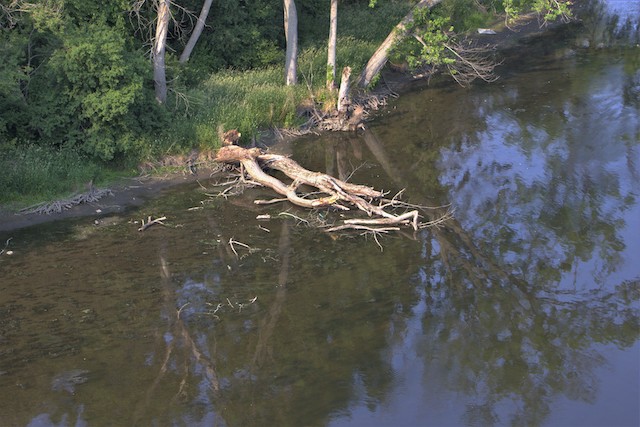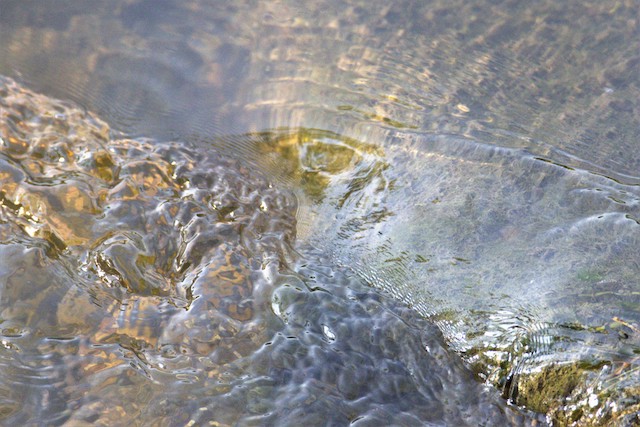Back in 2005, I wrote a column for the Friends of the Fox River’s newsletter entitled “How Green Is My River?” due to the incredible algae blooms that were going on that year. For much of that year, the river was a vivid pea-soup green: not healthy for river life and not very aesthetically pleasing either. I covered some of the reasons that the algae blooms were happening and what could be done to mitigate them. It is nice to be able to write a vastly different column this month!
Clear Water
This spring, the waters of the Fox River have been exceptionally clear. I have noticed it, my friends have noticed it, and many others have commented on it. In fact, while my friends Gene, Frank, and I were watching birds along the river at the Fox River observation platform in the Hoover Forest Preserve, we all commented about how clear the water was this year. I mentioned that the water on June 5th had the clarity it usually does in mid-winter. While we were discussing the unusual clarity of the water, my cellphone rang and it was Gary Swick, president of Friends of the Fox River (FOTFR) calling. Gary said he had just received numerous comments and inquiries about river clarity recently and wondered why it was happening. This column will pose some theories on why the clear water may be occurring so far this spring.

How Do the Physical Characteristics of a Watershed
Impact Water Clarity?
Water clarity is principally affected by the amount of particulate matter that is suspended in the water column. These particulates can consist of inorganic materials like silt and sand or organic materials like phytoplankton (algae), zooplankton or other organic pollutants. The more particulate matter in the water the murkier it will be. There are several varied factors that affect the amount of particulate matter present in the Fox River.
As environmentally aware residents of the Fox River watershed (or any watershed for that matter), it’s important to know how precipitation that falls in the watershed makes its way to the river. In a perfect natural watershed, rain and snow would fall on land populated by native vegetation that had evolved over eons to occupy specific niches in the ecosystem. Part of the ecosystem services of these native plant communities was to 1) to conserve soil (greatly limiting erosion of topsoil into waterways) 2) to store and filter the excess water that did fall onto the land (as precipitation prior to its release into the river). Rain and snow that fell in this natural watershed would work its way slowly through this natural system and arrive at the river in a form nearly as clear and pristine as it was when it first fell from the sky.
We do not live in a perfect natural watershed though. As people moved into the watershed long ago, they began to modify the natural ecosystem that was present to better suit societal needs. Land and plant communities were modified to provide places for people to live, to travel from place to place, and to grow food. Some trees were cut down to provide lumber for housing, virgin prairie was plowed to provide fields to grow agricultural crops and to provide food for an increasing population. In more modern times, more plant communities were removed in favor of manicured lawns, roads, parking lots, shopping centers, offices, and factories. As agricultural methods became more efficient, farmland was turned into places for people to live, work and shop. This process of modifying natural systems to suit societal needs continues to this day. There is nothing inherently wrong with this process as we all enjoy the benefits of living in a modern society.
However, the modifications made to the watershed had an enormous impact on how quickly water made its way to the river after falling from the sky as precipitation. The elimination of large tracts of native plants and wetlands also decreased the watershed’s ability to naturally filter impurities prior to the water reaching the river. Water that fell on the developed watershed made its way more quickly to the river and carried silt from the farm fields with their exposed topsoil and nutrients in the form of fertilizer from both agricultural fields and residential lawns. Impurities from roadways and other hard surfaces also made their way to the river.
Specific Systemic Factors That Can Impact Water Clarity
So, how does all this impact water clarity on the Fox River in the shorter term, and why does the river seem clearer this spring than it has in other years? As in all things, there is no single, simple reason. Water clarity depends on a lot of factors. One major factor that certainly is affecting the clarity of the river this spring is the relative scarcity of rain. The lack of rain has certainly limited the amount of runoff flowing into the river, thus decreasing the amount of silt, one of the nonorganic particulates that increase turbidity in the Fox River. The lack of rain and the runoff it brings has also resulted in less non-point source nutrients (agricultural and lawn fertilizers, primarily consisting of phosphorous and nitrogen) flowing into the river, keeping algae growth down.
Another less obvious reason for lower amounts of suspended algae (green, brown, and blue green) being reported in the Fox could be the increased number of vascular water plants that are growing in the Fox River in recent years. Fifteen years ago, it was very uncommon to see plants like Elodea or American Pondweed growing in the river. Now, these submerged aquatic plants are common. In pond environments, research has shown that these vascular plants compete successfully with algae for the available nutrients in the water, resulting in less algae growth. Perhaps this finding can be generalized to a riverine environment. I have seen some anecdotal evidence of this on the nearby DuPage River that has been consistently clearer than the Fox over the years and has always been loaded with Elodea and other submergent water plants.
Finally, the water treatment plants along the river have been doing an excellent job of limiting the amounts of nutrients like phosphorous and nitrogen they discharge into the river. This has been a long-term trend that started way back in the early 1970’s with the advent of the Clean Water Act. Wastewater treatment managers have made great strides in ensuring that the effluent from their plants meets or exceeds federal standards. They should be applauded for that. Similarly, land developers have been good stewards by erecting silt fencing or bales to prevent silt from running off construction sites and into either storm sewers, tributary streams, or the Fox River itself.

Conclusion: What Can We Do to Help the Fox River
Remain Clean and Clear?
All these factors (and certainly others) working systemically together have provided a nice, clear river for us this spring. As concerned stewards of the river, we should remain vigilant to ensure that we do all we can to maintain and optimize the conditions in the watershed. Keep a close watch on conditions affecting the river and report any issues that you see to the Illinois Environmental Protection Agency, the Illinois Department of Natural Resources, and to us here at Friends of the Fox River. Also, consider writing to your state and federal representatives to ask that they ensure that the strong water laws we have in place are not weakened. That would risk all the progress that our river has made in cleaning itself over the last 50 years.
Working together, we can make a difference in helping our beautiful Fox River continue to flourish as the incredibly valuable natural resource it is to our area. Thanks for your help!

